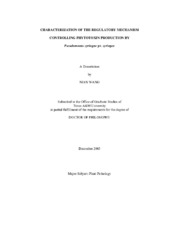| dc.contributor.advisor | Gross, Dennis C. | |
| dc.creator | Wang, Nian | |
| dc.date.accessioned | 2007-04-25T20:06:07Z | |
| dc.date.available | 2007-04-25T20:06:07Z | |
| dc.date.created | 2005-12 | |
| dc.date.issued | 2007-04-25 | |
| dc.identifier.uri | https://hdl.handle.net/1969.1/4753 | |
| dc.description.abstract | Syringopeptin (syp) and syringomycin (syr) are major necrosis-inducing
lipodepsipeptide phytotoxins produced by P. syringae pv. syringae. This report
demonstrates that syringopeptin production is activated by plant signal molecules.
Syringopeptin production by BR132 was increased two-fold by addition of arbutin (100
µM) and D-fructose (0.1%) to syringomycin minimal medium (SRM). Subgenomic
analysis of transcriptional expression with a 70-mer oligonucleotide microarray
demonstrated that the syr-syp genes are induced 2.5- to 10.5-fold by arbutin and
D-fructose. The syr-syp genomic island was found to be organized into 12
transcriptional units based on reverse transcriptional PCR (RT-PCR) and computer
analysis. The transcriptional start sites of the salA gene and operons III and IV were
located 63, 75, and 104-bp upstream of the start codons of salA, syrP, and syrB1,
respectively, using primer extension analysis. The predicted -10/-35 promoter region of
operon IV was confirmed based on mutagenesis analyses of the syrB1::uidA reporter
with β-glucuronidase (GUS) assays. A 20-bp conserved sequence (TGTCccgN4cggGACA) with dyad symmetry around the -35 region was identified via
computer analysis for the syr-syp genes/operons responsible for biosynthesis and
secretion of syringomycin and syringopeptin. Expression of the syrB1::uidA fusion was
decreased 59% when 6-bp was deleted from the 5’ end of the syr-syp box in the
promoter region of operon IV. These results demonstrate that the conserved promoter
sequences of the syr-syp genes contribute to the co-regulation of syringomycin and
syringopeptin production. Microarray analysis established that the syr-syp genes
responsible for synthesis and secretion of syringomycin and syringopeptin belong to the
SyrF regulon. Vector pMEKm12 was successfully used to express both SalA and SyrF
proteins fused to maltose-binding protein (MBP). Both MBP-SalA and MBP-SyrF
fusion proteins were purified with maltose-affinity chromatography. Gel shift analysis
revealed that the purified MBP-SyrF, but not the MBP-SalA fusion protein, bound to a
262-bp fragment containing the syr-syp box. Purified MBP-SalA caused the shift of a
324-bp band containing the putative syrF promoter. Gel filtration analysis or
cross-linking experiments indicated that both SalA and SyrF form dimers in vitro. This
study may provide an important perspective on the regulation of syringomycin and
syringopeptin production. | en |
| dc.format.extent | 1185620 bytes | en |
| dc.format.medium | electronic | en |
| dc.format.mimetype | application/pdf | |
| dc.language.iso | en_US | |
| dc.publisher | Texas A&M University | |
| dc.subject | syringomycin | en |
| dc.subject | syringopeptin | en |
| dc.title | Characterization of the regulatory mechanism controlling phytotoxin production by Pseudomonas syringae pv. syringae | en |
| dc.type | Book | en |
| dc.type | Thesis | en |
| thesis.degree.department | Plant Pathology and Microbiology | en |
| thesis.degree.discipline | Plant Pathology | en |
| thesis.degree.grantor | Texas A&M University | en |
| thesis.degree.name | Doctor of Philosophy | en |
| thesis.degree.level | Doctoral | en |
| dc.contributor.committeeMember | Chen, Jeffrey Z. | |
| dc.contributor.committeeMember | Gonzalez, Carlos F. | |
| dc.contributor.committeeMember | Kolomiets, Michael V. | |
| dc.type.genre | Electronic Dissertation | en |
| dc.type.material | text | en |
| dc.format.digitalOrigin | born digital | en |


